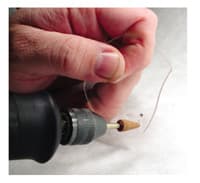Eye on Equipment
Working With Trivex
By Erinn Morgan
Introduced nearly two years ago by PPG Industries (the inventor of CR 39), lenses made of the Trivex material have quickly gained acceptance. Trivex offers strength and impact-resistance, light weight and thinness, and quality optics.
|
|
|
|
Phoenix lenses from Hoya edge like most polycarbonate, with some special handling |
|
Today, three companies offer their own version of lenses made of Trivex--Hoya's Phoenix, Younger's Trilogy, and, most recently, Bangkok-based Thai Polymer's Excelite-TVX, which is slated to launch sales to U.S. distributors starting toward year's end.
As with anything new, there were growing pains associated with the learning curve for processing Trivex. However, many labs say this curve was slight, due to Trivex's similarity in processing to other materials.
"When CR 39 and poly were new to the industry, the learning curve was much greater," says Rick Tinsen, president of Hoya Hartford (formerly QSA), a Hoya Lab in Hartford, Conn.
Still, there are many facets to processing this new material. Here we offer tips from several pros: Tinsen; Jerry Dooley, commercial development manager, optical monomers, for PPG; Dale Parmenteri, president of Balester Optical, a lab in Wilkes-Barre, Penn.; and Geff Heidbrink, president of Harbor Optical, a lab in Traverse City, Mich.
Does Trivex process similar to other materials?
TINSEN: It is similar to polycarbonate, but there are a couple of areas where Trivex is a little trickier than poly. You start with the poly process and move it from there.

|
|
|
(Left) Trivex is a strong choice for a drilled rimless frame. (Right) Trivex lenses including Younger's Trilogy should cool for 30 minutes prior to generating |
|
Does it require new equipment?
DOOLEY: It can be processed on the same equipment we've all been using. But it is a new material, so it doesn't process exactly like anything else. But with a little bit of trial, anyone can process it. Trivex has benefited from people learning how to deal with other materials.
What is the best way to edge Trivex--wet or dry?
TINSEN: I know of one lab that is edging it wet. When we tried to wet edge it, the lens just didn't come down to size. It is really machine dependent. In edging, it generally acts like poly, but it melts just a little bit easier, so you end up with some issues of melted swarf.
I have also seen some equipment combos produce an amazing amount of dust when edging it dry. We developed a way of collecting the dust so it is no longer as much of an issue.
The way we edge Trivex is with a dry cut edger as opposed to grinding it on a diamond wheel. Many of the Hoya labs are doing the same.
How thin can Trivex be ground?
TINSEN: 1.0 maintains the great optics, but Hoya recommends 1.3mm because it maintains the physical integrity of the coatings and the optical clarity of the lens. If you go below 1.3, we suggest you test lenses and look for crazing of the coating.
DOOLEY: I have heard one story where Three Rivers Lab processed it down to .6mm center thickness (that's like a potato chip) just to see how low they could go. They checked it and found it stayed on power. Of course, no one makes it that low because it is not practical, but it is still pretty amazing.
Also, Younger Optics recommends 1.0mm for the Trilogy lens.
How well does Trivex tint?
PARMENTERI: It tints very well, whereas polycarbonate does not. If I were dispensing and somebody wanted a tint, I would undoubtedly recommend Trivex.
What about edge polishing?
HEIDBRINK: The edges polish beautifully. It's a similar process to polishing poly. We use the polish setting on the edger and put them on the handwheel.
TINSEN: It is similar to polycarbonate in polishing edges, which is a good and bad thing. You can give it the high luster most people associate with poly. But you are also going back to certain edging issues such as the problem with railroad tracks for which you have to be on the lookout.
Any edge polishing technique needs to get rid of those tracks. We worked with [our suppliers] to come up with a modified edge polish cast that got rid of them.
Is Trivex good material for processing rimless eyewear?
PARMENTERI: We will not warranty CR 39 in a drilled rimless frame because it will flake and crack. Poly is better, but you will still have some of the same pressure issues. Trivex is the best for this. In fact, we have a promotion running for the next three months to promote Trilogy Trivex in drilled rimless frames.
TINSEN: We actually now produce more Trivex Phoenix drills than poly drills. In our initial drill test I said, 'Wreck them,' and they couldn't. It also lowered our do-over rate. And when you compare Trivex to poly, the thickness is sometimes the same, but Trivex is still eight to nine percent lighter.
HEIDBRINK: That is our lens of choice for all the drilled rimless that we do. We were a beta test site for both Hoya and Younger and now we do about 600 pair a month.
|
Tips on Processing Trilogy |
| SURFACING
FINISHING
Source: Younger Optics Trilogy Processing Guide Tips on Processing Phoenix EDGING
Source: Hoya Optical Labs of America |





